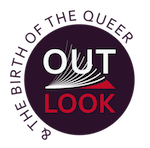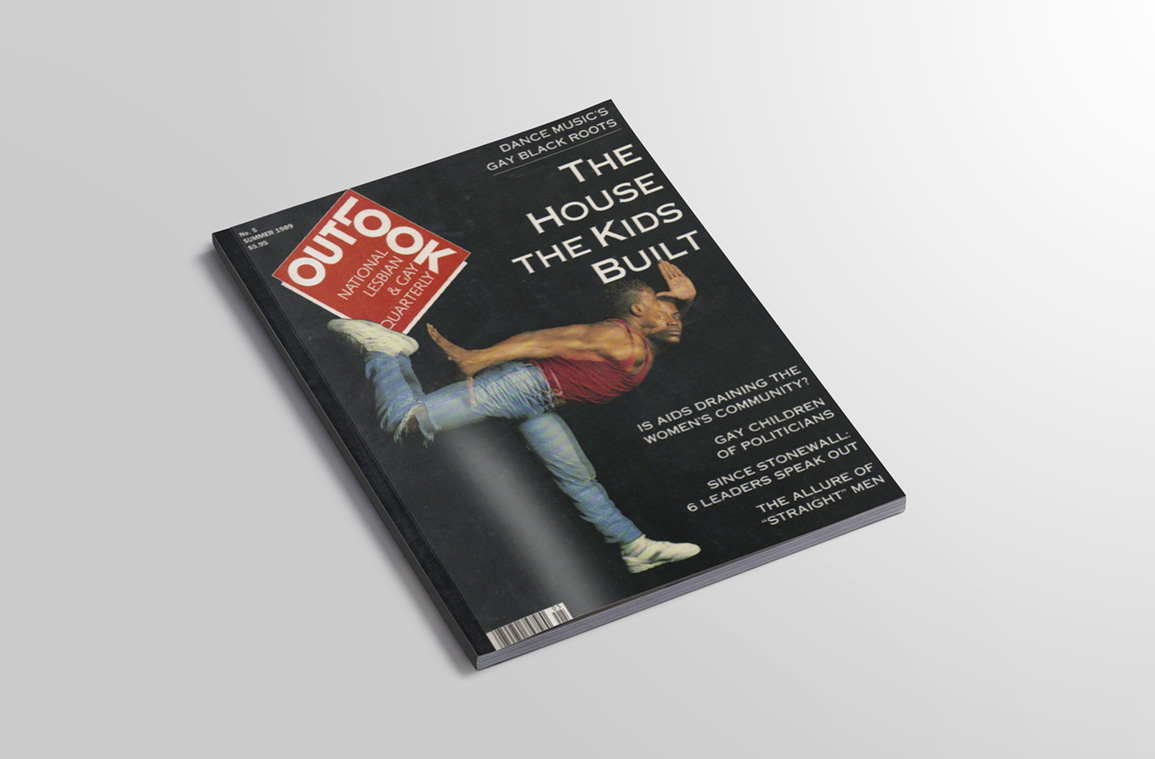
My first response to Issue #5: Where are my (trans) people? My next response: I was struck by how many of the themes that jumped out from the pages from 1989 (assimilation, whitewashing, tokenism, the silencing of Black queers, activist balance versus burnout) … are many of the same themes of today’s movements for trans and queer and QTPOC justice. It’s ultimately the entire issue that drives my artistic response, my heart pulled in by the complete absence/erasure of my people here.
Lightning Strikes:
OUT/LOOK – Issue Number 5
Summer 1989
by Sean Dorsey
My first lightning strike is Ah! How glorious to be holding actual 1989 paperstock manifesting the sacred dreams, blazing imagination, fury, fatigue, reporting and uncompromising determination of my queer family. And from 1989, no less! Heart of the early AIDS epidemic, a time embedded deeply in my heart and in my art.
I devour the issue. It’s what I do. I’m a queer history nerd – I can’t help it.
But then. I shake my head (probably imperceptibly), scour the pages again, cover to cover, searching. The way a tongue returns again and again, instinctively, to a missing tooth.
As a transgender and queer artist, I am drawn to the inaccuracies of History – specifically, the gaps that have been chiseled out of the official story … and the effort and electricity it takes us to fill those gaps (if ever).
Our exclusion from The Great Story of History is part of what drives me as an artist and activist.
But here it is, in my hands, an artifact of lesbian and gay Truths and Responses from 1989. And with exquisite totality, my people are not there.
* * * * *
My second lightning strike is Ah! There we are not. Again. With exquisite totality trans is not there. I wonder how on earth to best relate to this artifact for my assigned response.
You see, it’s not that trans people didn’t exist in Summer 1989. It’s that cisgender lesbian and gay and straight people didn’t see us, or didn’t know us, or didn’t like us, or didn’t want to have anything to do with us, or didn’t believe in kinship or solidarity with us (or any combination of the above).
Two seemingly disparate truths can co-exist (and often do). On one hand, I want to acknowledge that this OUT/LOOK issue-artifact is important and trailblazing and powerful, and will deeply move many lesbians and gays and bi folk and queers reading it today. And. I yearn even more to acknowledge that this issue-artifact also denies my community’s very existence.
Both. And. Two truths are here. Your resonance and joy with this artifact are true. So are my sadness and anguish that 1989’s important, trailblazing, powerful, beautiful trans people have (once again) fallen between the pages of official history. In 1989, no less! Heart of the early AIDS epidemic.
* * * * *
Lightning strike: one of the most bitter, most unspoken truths of the early AIDS epidemic is that transwomen’s communities – especially transwomen of color’s communities – were decimated during the epidemic. This has yet to be acknowledged by (cisgender and mainstream) history.
In 1989, “It was like they weren’t even seeing us die,” Black HIV+ transwoman activist-warrior Cheryl Courtney-Evans tells me when I record an oral history interview with her in Atlanta, GA on May 26, 2014.
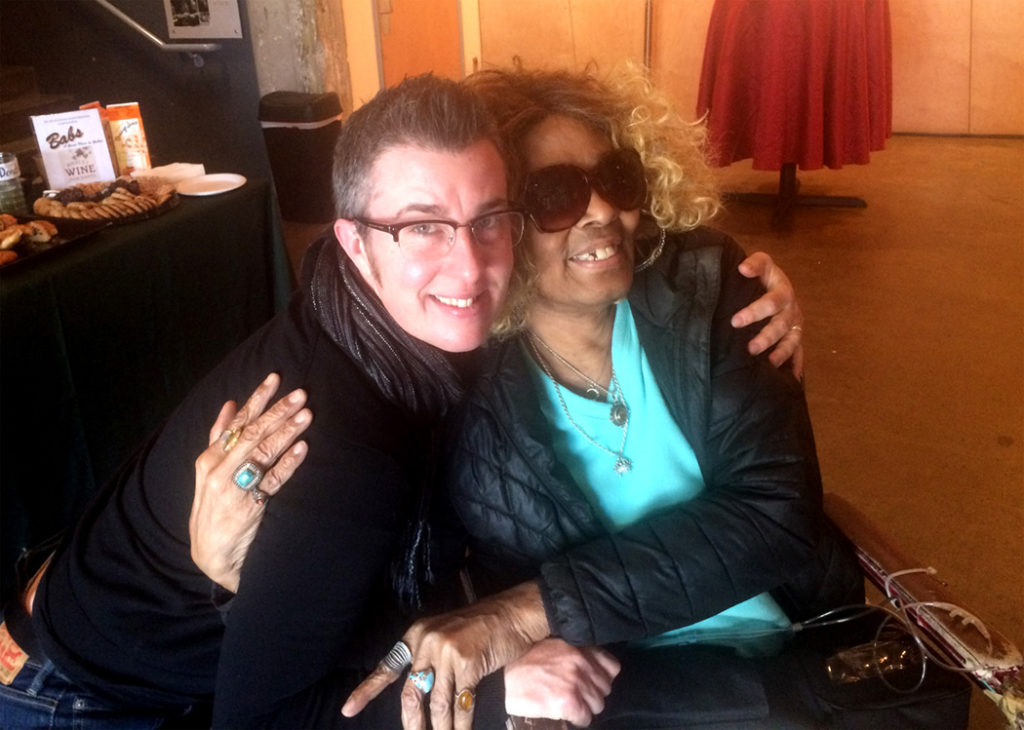
Sean Dorsey and Cheryl Courtney-Evans at the Atlanta premiere of THE MISSING GENERATION in February 2016 (photo: Heidi Howard)
In 1989, Ms. Cheryl had already been living with HIV for 7 years. Remember, this is 1989: this is pre-protease-inhibitors, pre-AIDS-cocktails, pre-trans rights protections of any kind, pre-trans resources of ANY kind; an apex of right-wing attacks on poor people of color, trans people, queers.
As evidenced by the title “OUT/LOOK: National Lesbian and Gay Quarterly,” 1989 was an entirely pre-“LGBT” era. As hard as it is for some young folks today to imagine, there was no term “LGBT” yet, because the L and G and the B did not yet have any sense of kinship or solidarity with the T. And at best, left us T’s out of the party; and at worst, degraded and harmed us.
So in every way, T’s were left to fend for ourselves. We took care of our own, in the face of total abandonment by everyone else.
In 1989, Ms. Cheryl was a leader and a warrior, fighting hard for survival, community and justice for transwomen of color living with HIV, stigma, Reagan-exacerbated poverty and homelessness, racism and daily discrimination by gays and lesbians and straight people.
Ms. Cheryl died last year. Many of us are fighting for her rightful place in recorded history and archives and art. She’s a big part of our Great Story. But she’s also falling between the pages of recorded history.
* * * * *
I am (in no particular order) a transgender and queer choreographer, writer, dancer, activist. Over the last 10 years I’ve choreographed a trilogy of full-length dances that reveal parts of previously censored, buried, forgotten or untold transgender and queer history.
I created the trilogy after conducting hundreds of hours of archival research (some at the GLBT Historical Society), and after recording over 100 hours of oral history interviews with trans and queer people across the US.
I incorporated this research and these remarkable real-life voices and stories into each dance’s soundscore, and toured these shows to 27 cities. I got to bring this sacred trans and queer history into the hearts and minds of thousands of people.
Since 2002, I’ve also supported and presented more than 500 transgender, gender nonconforming and queer artists through my San Francisco nonprofit arts organization Fresh Meat Productions.
So I (literally and figuratively) have a lot invested in trans and queer folks’ stories being inserted into The Great Story of History, and in us making, creating, dreaming and living our OWN unique Great Story.
* * * * *
The journey began in 2008, when I first met Lou Sullivan (1951-1991), a female-to-male transsexual gay man who lived and died in San Francisco and was a trailblazing activist, historian and writer. Or rather, when I came to know him through his archival collection at the GLBT Historical Society: his lifelong diaries, personal correspondence, activist notes, medical records, research and pages and pages of wonderfully kinky drawings. Sullivan inspired the first work in my trilogy: Uncovered: The Diary Project (2009).
Because Lou Sullivan lived and died as trans before the Internet, almost nobody today knows about him – despite the fact that he is undisputedly one of our community’s most important pioneers.
Sullivan was a tireless activist and broke down countless barriers for trans people – including getting the medical establishment to stop refusing gender-therapy to trans people who identified as gay or lesbian or queer. You know that thing we take for granted now, that gender identity and sexual orientation are not the same thing? Yeah: Lou had a lot to do with forging that change in cultural consciousness.
Sullivan conducted early trans historic research, publishing, support group creation, started an international FTM newsletter, and personally corresponded with trans people living in isolation all around the world.
Lou Sullivan was also a founding Board member of the GLBT Historical Society, the organization who that took loving care of his archives after he died.
* * * * *
Lightning strike: In 1989, Sullivan was living with AIDS. Knowing with certainty that he was going to die, he was running against the clock – fiercely advocating, educating and writing. And preparing his papers for the archives.
Lou bequeathed his diaries hoping they would be read. I do exactly this – and I then transcribed and distilled his diary writings into a soundscore and choreographed a suite of dances for my all-queer dance company, based on Sullivan’s remarkable journey.
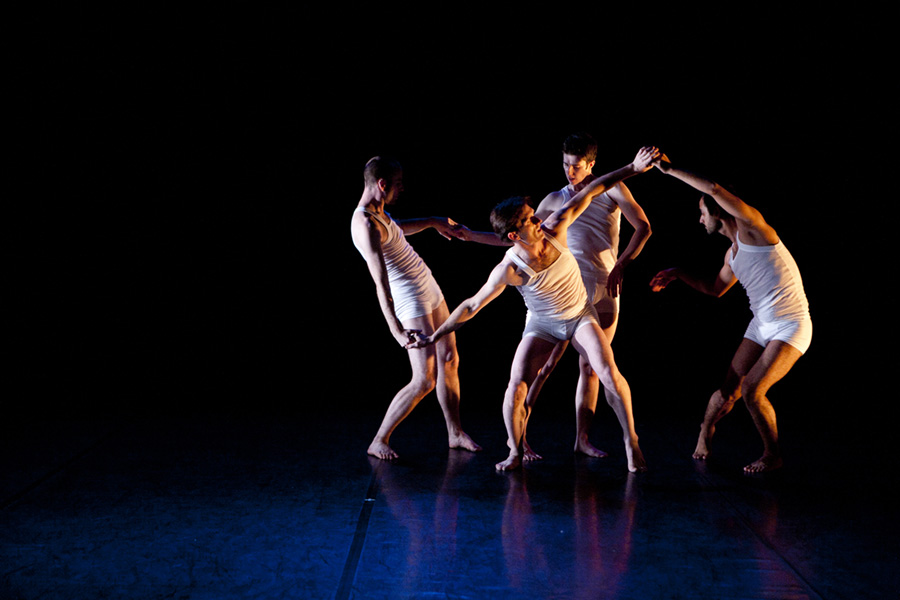
Sean Dorsey Dance performing “Lou” from Uncovered: The Diary Project in San Francisco in 2008 (photo: Lydia Daniller)
Through Uncovered: The Diary Project’s performances, panels and related exhibitions, I introduced thousands of people to the activism, dreams, creativity, resilience and generosity of Lou Sullivan.
* * * * *
Lighting strike: In 1989, heart of the AIDS epidemic, “there were no, literally NO services for trans people,” says Javon Egyptt, a Black transwoman activist I recorded an oral history interview with on October 18, 2013 in New York City.
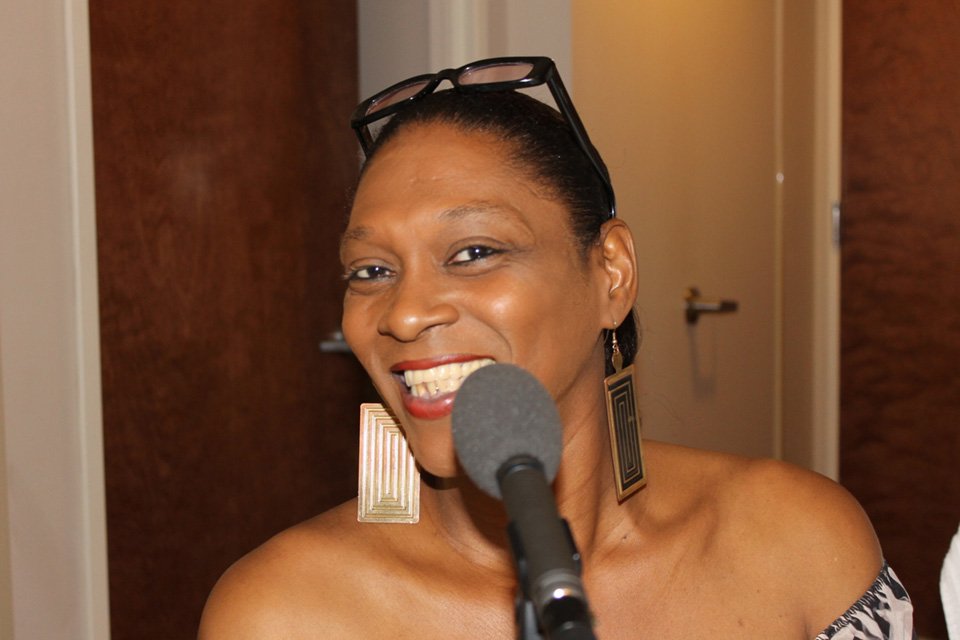
Javon Egyptt in New York City in October 2013 (photo: Sean Dorsey)
It’s 2013 and I’m in the community research phase for the third piece in my trilogy, THE MISSING GENERATION – a full-length dance-theater production that gives voice to transgender and LGBQ longtime survivors of the early AIDS epidemic.
To create the work, I spent a year traveling the US and recorded 75 hours of oral history interviews. After spending over 500 hours listening to these people’s devastating, gut-racking, inspiring, hilarious, vulnerable, powerful stories, I built a multi-layered soundscore that included excerpts of these interviews, original music by my team of composers, and my own writing and narration.
THE MISSING GENERATION calls us to attune ourselves and attend to these survivors – to witness and hold their long-buried stories, grief, rage and love. I ask audiences to reckon with this important period of history and its survivors, on whom our culture has turned its back.
In New York, Javon Egyptt talked to me about how, in the 1980s, she and her trans sisters would walk into gay AIDS organizations, looking for support … and get laughed out the door. She told me one reason transwomen wouldn’t get tested was because many gay clinics would ignore them in the waiting room or do nothing with their intake forms. She talked about how some New York gay clubs would ban entrance to transwomen.
Egyptt said, “Trans people didn’t have any rights back then. You were non-existing. You were a freak. You were an abomination. You were wrong.”
* * * * *
Lightning strike: There are so many extraordinary people I’d love to have written about for OUT/LOOK’s Summer 1989 issue:
In 1989, transwoman activist-warrior Dee Dee Chamblee, founder of LaGender Inc, is working, volunteering, organizing and supporting transwomen living with HIV in Atlanta GA. Chamblee has been living with HIV since 1987.
In 1989, transwoman Tamara Ching is fighting for the rights of trans sex workers and trans people living with HIV in San Francisco.
In 1989, Miss Major Griffin-Gracy is bringing together activists and resources for justice for trans prisoners in San Diego (and later in San Francisco).
In 1989, Kate Bornstein is getting ready for the San Francisco world premiere of her play Hidden: A Gender – one of the US’ first plays with openly trans themes and actors.
In 1989, Jamison Green (who took over the FTM Newsletter when Lou Sullivan died) starts giving workplace trainings and presentations about transsexual and transgender issues.
In 1989, Compton’s Cafeteria riot veteran Felicia Elizondo (Felicia Flames) is working tirelessly for justice for transwomen living with HIV; she has been living with HIV two years.
In 1989, trans icon, self-described drag-queen and Stonewall veteran Sylvia Rivera (1951-2002) speaks out against assimilationist lesbian and gay movement strategies, and continues her uncompromising fight for trans liberation and racial justice.
* * * *
Lightning strike: It’s 2017, and I’ve been asked to re-visit a room that’s been locked away for decades: OUT/LOOK Summer Issue, 1989.
But it’s not just the room that’s been locked away – it’s my people; they’re inside the locked room, unnamed and forgotten there since 1989.
I open the door and the sky splits open with storm. Flashing light strains to reach the room’s corners. I ache to touch and charge these forgotten people and places with this lightning’s long bright arm – to illuminate the corners and bring them to center.

